Here are tips and suggestions on how to correct common paint problems. Homeowners all
over the country experience these types of problems. Take the time to read the
instructions carefully and follow them, and you can correct many of the paint problems
around your home.
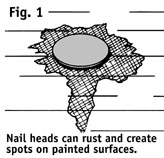 |

STAINED SPOTS FROM RUSTING NAIL HEADS
- Nail heads can rust and create spots on painted surfaces in your home. This problem is
caused by using uncoated steel nails where excessive moisture exists under the paint (Fig.
1). The uncoated steel nails obviously cannot be removed, but you can correct the
moisture problem.
- Try to locate the source of excessive moisture. Check for leakage from the eaves,
evaporation from nearby plumbing pipes, sweating caused by heat from a bathroom or
kitchen. If you can locate the source of moisture, try eliminating the problem by shutting
off the condensation that causes the moisture.
- Remove any stained paint around all nail heads by sanding the area or using a wire
brush. Sand clear down to the nail head, then sand the nail head itself to remove the
built-up rust.
- Use a nail punch to countersink all nail heads approximately 1/8" below the wood
surface.
- Apply one even layer of undercoat over the countersunk nail and the area around it.
- After the area is primed, fill the countersunk hole with a good grade of caulking
compound. Allow the compound to dry, then apply one coat of a good grade of outside house
paint. After adequate drying time, apply a second coat. Use these steps to correct the
problem.
|
 PEELING PAINT UNDER THE OVERHANG OF
A ROOF
PEELING PAINT UNDER THE OVERHANG OF
A ROOF
- Paint sometimes peels under the overhang of a roof or in other areas of your home that
are protected from weather. Such peeling is usually caused by a build-up of
"salt" deposits, which are normally washed away by rain in exposed areas.
- Your first step is to remove the peeling paint by sanding the surface thoroughly.
- After sanding, prepare a solution using a cleaner that leaves no film such as trisodium
phosphate and water. Wash the sanded surface with this solution. Rinse the area with clear
water and allow it to dry.
- After the surface has dried completely, apply two coats of a good grade of undercoating
paint.
- When the undercoat has thoroughly dried, apply a coat of a top-quality house paint.
Under some conditions, two finish coats may be required. This treatment should correct the
peeling problem.
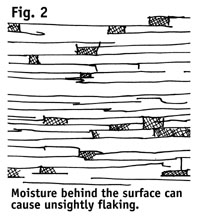 |
 FLAKING
PAINT FLAKING
PAINT
- Paint flaking is caused by moisture that collects behind the painted surface (Fig. 2).
Moisture enters the wood siding from the unpainted side. The absorbing and drying of the
moisture causes repeated swelling and shrinking, thus breaking the paint film and causing
it to pull away from the wood surface.
- The first step is locating the source of the moisture. Check the area for leakage from
the gutters or eaves of the house. If the flaking paint is near a bathroom or kitchen, the
pipes may be sweating or leaking, or excess heat may be causing condensation.
- You may need to install attic louvers, moisture vents or exhaust fans to correct the
build-up of moisture.
- Scrape and sand away all flaking paint. Remove the paint as far as 12" in all
directions beyond the flaking area.
- Sand the surface down to the unpainted wood, and spot prime the area with a good grade
of undercoat.
- Protect the area against moisture by caulking all seams, holes and cracks that appear in
the freshly sanded area.
- After the caulking compound has thoroughly dried, apply at least one coat of a
top-quality house paint according to the manufacturer's directions. You may need to apply
two coats. These steps should completely resolve the problem.
|
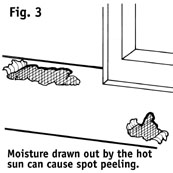 |
 SPOT
PEELING SPOT
PEELING
- Spot peeling sometimes occurs on the siding of a house in areas exposed to the sun's
heat (Fig. 3). Peeling is usually caused by moisture trapped in the siding that is
drawn to the surface by the sun's rays. The moisture lifts the paint away from the
surface.
- The first step is locating the source of the trapped moisture. Check carefully for leaks
in the gutters or eaves of the house. If the peeling area is near a kitchen or bathroom,
you may need to install an exhaust fan to remove the moisture and sweat buildup.
- Louvers placed in the overhang of the root - or wedges and vents placed in the siding -
sometimes allow the trapped moisture to escape.
- Remove all the old paint in the peeling area. Scrape off the paint approximately
12" beyond the peeling area.
- Sand the surface down to the original wood, and prime it with a good grade of wood
undercoat.
- Caulk all holes, cracks and seams with a good grade of caulking compound to avoid a
repeat of the problem.
- After the caulking compound has had time to dry thoroughly, apply at least one coat of a
good grade of house paint. This should completely correct the problem.
|
 PEELING DOWNSPOUTS AND GUTTERS
PEELING DOWNSPOUTS AND GUTTERS
- Gutters and downspouts normally peel because they were not properly treated and primed
when originally painted. Galvanized metal usually has a thin, invisible film that causes
many paint problems.
- Remove the loose paint from the downspouts and gutters with a wire brush, scraper or
some other stiff tool. Use a power brush or power sander for big projects.
- Be sure that all loose paint is removed. Otherwise, the problem will occur again after
another painting. Don't take shortcuts - correct the problem now by doing the job right.
- If you are using latex-based paint, clean the sanded area with a good grade of solvent.
Apply a heavy coat of the solvent and allow it to evaporate. Special solvents are
available for treating galvanized metal.
- After the solvent has evaporated, apply the latex paint directly to the bare galvanized
area. For large areas, finish the job with two top coats.
- If you are using an oil-based paint, prime the sanded areas with a good grade of metal
primer. After the primer has dried, apply one coat of a good grade of metal paint.
- Finish the job with at least one coat of a good-quality house paint. Use two coats in
extreme cases.
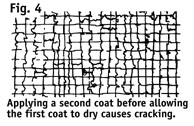 |
 CRACKING
OR ALLIGATORING CRACKING
OR ALLIGATORING
- Extreme cracking, sometimes known as alligatoring, is caused when a second or third coat
of paint is applied before the previous coat dries completely(Fig. 4).
- In some cases, cracking or alligatoring is caused when the undercoat is incompatible
with the type of finish coat applied to the surface.
- The only solution is to completely sand away the cracked or alligatored surface. Use
power sanding or brushing equipment for large areas.
- After the cracked or alligatored paint is completely removed from the surface, brush the
area thoroughly to remove dust and loose paint particles. Apply one coat of a good quality
undercoat paint.
- Allow the undercoat paint to dry thoroughly, then apply a second coat of a top-quality
house paint of the desired color. This completely corrects the problem.
|
 CHECKING OF A PAINTED SURFACE
CHECKING OF A PAINTED SURFACE
- Checking usually occurs on a painted plywood surface. As the plywood veneer ages, it
cracks from repeated expansion and contraction. This weathering and aging causes the
painted surface to check.
- When checking occurs, the entire checked area must be sanded smooth. The job will be
easier with a power sander.
- After the sanding is complete, prime the bare wood with one coat of good grade
undercoat.
- Fill all holes, cracks and seams with a good grade of caulking compound.
- After the caulking compound and undercoat paint have dried thoroughly, apply one layer
of a good grade of outside house paint.
- In cases where the plywood is extremely aged, you may need to replace the wood
completely.
- If new plywood is mounted, you can prevent it from checking by sanding the surface of
the new plywood smooth.
- After sanding, apply one coat of a good grade of latex wood primer.
- After the primer has thoroughly dried, apply one or two coats of a top-quality outside
house paint.
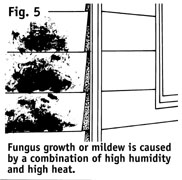 |
 MILDEW ON
PAINT MILDEW ON
PAINT
- Mildew is caused by a combination of high humidity and high temperature that creates a
growth of fungus on the paint film(Fig. 5).
- Completely remove mildew from the surface. If you simply paint over it, the mildew will
grow right through the new coat of paint.
- Make a solution of 1/3 cup of powdered detergent and 1/2 cup of household bleach mixed
in one gallon of warm water.
- Scrub the entire mildewed surface thoroughly using this solution. Scrub the area
vigorously, then rinse lightly with clean water.
- Apply one coat of a good grade of undercoat paint, and allow it to dry.
- After the undercoat layer has thoroughly dried, apply a finish coat of mildew-resistant
outside paint or a top-grade of latex outside house paint. This procedure will remove the
mildew problem.
|
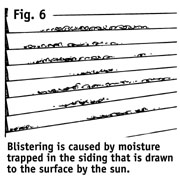 |
 BLISTERING BLISTERING
- Blistering is caused by moisture trapped in the wood that is drawn to the surface by the
sun's rays. As the moisture rises, it pulls the paint away from the surface and causes
blistering(Fig. 6).
- Locate the source of the excess moisture and eliminate it. Check first for leakage from
the gutters or eaves of the house.
- If the area is near a bathroom or kitchen, you may need to install an exhaust fan to
remove the excess heat, steam and moisture.
- You can also install moisture vents or wedges in the siding to permit the moisture to
escape.
- Scrape or sand away all the old paint in the blistered area down to the wood. Scrape the
unblistered paint out about 12" beyond the blistered area.
- Next, sand this area thoroughly, right down to the fresh wood. Then prime it with a good
grade of undercoat paint.
- Block future moisture problems by sealing all cracks, holes and seams with a good grade
of caulking compound.
- After the caulking compound and undercoat have dried thoroughly, apply a second coat of
a good grade of outside house paint. This eliminates the problem.
|
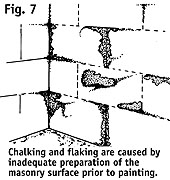 |

CHALKING AND FLAKING ON MASONRY SURFACES
- Chalking and flaking on masonry surfaces are usually caused by inadequate preparation of
the surface prior to painting. This causes the paint to flake off or powder (Fig. 7).
- First, remove the caulking or flaking with a wire brush or by sandblasting. If the job
is big, use power sanders or wire brushes.
- Next, seal all cracks with a good grade of concrete patch or caulk. After sealing the
cracks, apply masonry conditioner following the manufacturer's instructions.
- After the masonry conditioner has thoroughly dried, apply one or two coats of a good
grade of latex house paint or an exterior masonry paint. Your flaking problem is
corrected!
|
Tools And Material Checklist
| Paint |
Sponge |
Paint cleaner |
Steel Wool |
Sandpaper |
| Paint Scraper |
Sandpaper Holder |
Wire Brush |
Paint Remover |
Paint Brush |
| Power Sander/Brush |
Crack Filler |
Concrete Patch |
Patching Plaster |
Drop Cloth |
| Wood Putty |
Trowel |
Caulking Gun |
Caulk |
Putty Knife |
| Putty |
Roller Tray |
Paint Roller |
Paint Pail |
Brush/roller Cleaner |
| Glass Scraper |
Turpentine or Thinner |
Punch |
Exhaust Fan |
Louvers |
| Solvent |
Vents or Wedges |
Undercoat |










 PEELING PAINT UNDER THE OVERHANG OF
A ROOF
PEELING PAINT UNDER THE OVERHANG OF
A ROOF

 FLAKING
PAINT
FLAKING
PAINT 
 SPOT
PEELING
SPOT
PEELING  PEELING DOWNSPOUTS AND GUTTERS
PEELING DOWNSPOUTS AND GUTTERS

 CRACKING
OR ALLIGATORING
CRACKING
OR ALLIGATORING  CHECKING OF A PAINTED SURFACE
CHECKING OF A PAINTED SURFACE

 MILDEW ON
PAINT
MILDEW ON
PAINT 
 BLISTERING
BLISTERING

